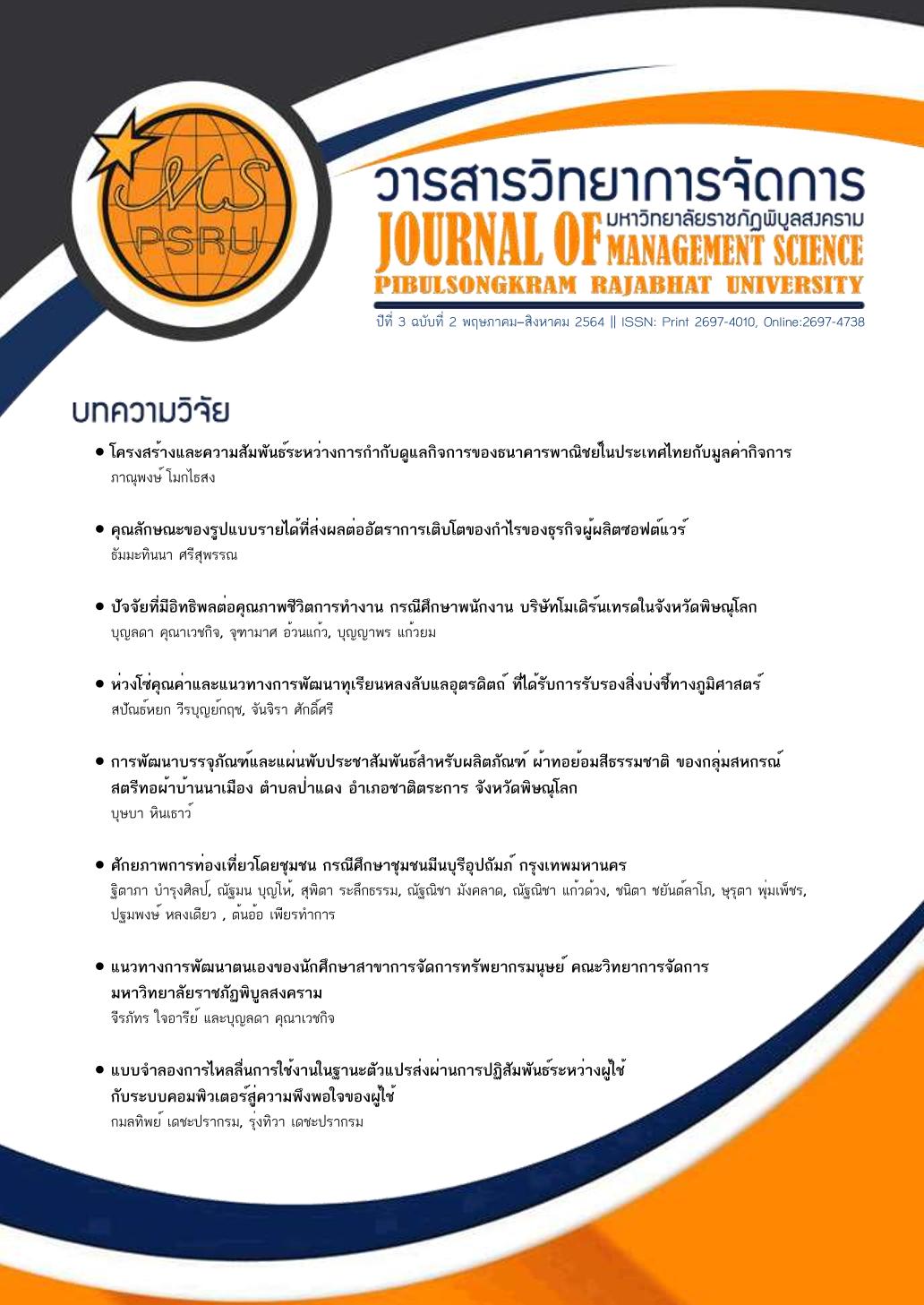แบบจำลองการไหลลื่นการใช้งานในฐานะตัวแปรส่งผ่านการปฏิสัมพันธ์ระหว่างผู้ใช้กับระบบคอมพิวเตอร์สู่ความพึงพอใจของผู้ใช้
คำสำคัญ:
การปฏิสัมพันธ์ระหว่างผู้ใช้กับระบบคอมพิวเตอร์, การไหลลื่นการใช้งาน, ความพึงพอใจของผู้ใช้บทคัดย่อ
การวิจัยครั้งนี้มีวัตถุประสงค์คือ 1) เพื่อศึกษาแบบจำลองความพึงพอใจของผู้ใช้ที่เกิดจากการปฏิสัมพันธ์ระหว่างผู้ใช้กับระบบคอมพิวเตอร์และการไหลลื่นการใช้งาน และ 2) เพื่อศึกษาแบบจำลองการไหลลื่นการใช้งานในฐานะตัวแปรส่งผ่านความสัมพันธ์ระหว่างการปฏิสัมพันธ์ระหว่างผู้ใช้กับระบบคอมพิวเตอร์สู่ความพึงพอใจของผู้ใช้ เป็นการวิจัยเชิงปริมาณ เก็บข้อมูลจากกลุ่มผู้ซื้อสินค้าออนไลน์ 599 คน เลือกกลุ่มตัวอย่างแบบลูกโซ่ วิเคราะห์ข้อมูลตัวแบบสมการโครงสร้างด้วยโปรแกรม AMOS
ผลการวิจัยพบว่า 1) แบบจำลองความพึงพอใจของผู้ใช้ที่ประกอบด้วยการปฏิสัมพันธ์ระหว่างผู้ใช้กับระบบคอมพิวเตอร์และการไหลลื่นการใช้งานมีความสอดคล้องกับข้อมูลเชิงประจักษ์อยู่ในเกณฑ์ดี (c2 = 32.932, df = 23, p-value = 0.082, c2/df = 1.432, GFI = 0.988, RMSEA = 0.027 ) 2) ปัจจัยที่ส่งผลต่อความพึงพอใจของผู้ใช้คือการไหลลื่นการควบคุมการใช้งานมีอิทธิพลรวม 0.668 รองลงมา การปฏิสัมพันธ์ระหว่างผู้ใช้กับระบบคอมพิวเตอร์มีอิทธิพลรวม 0.320 ตามลำดับ โดยทั้ง 2 ปัจจัยร่วมกันพยากรณ์ความพึงพอใจของผู้ใช้ได้ร้อยละ 42.30 (R2=0.432) และ 3) การไหลลื่นการใช้งานเป็นตัวแปรส่งผ่านสมบูรณ์ (Full mediation) ระหว่างการปฏิสัมพันธ์ระหว่างผู้ใช้กับระบบคอมพิวเตอร์สู่ความพึงพอใจของผู้ใช้
เอกสารอ้างอิง
ประสิทธิชัย นรากรณ์. (2558). อิทธิพลของการไหลลื่น ความไว้วางใจในสมาชิก และการเผยแพร่ตัวตนในเครือข่ายสังคมออนไลน์ ในฐานะปัจจัยที่เชื่อมโยงการปฏิสัมพันธ์และความผูกพันของผู้ใช้สู่ผลการซื้อสินค้าออนไลน์ลัพธ์และความภักดีทางอิเล็กทรอนิกส์. กรุงเทพมหานคร: สำนักพิมพ์มหาวิทยาลัยรามคำแหง.
ประสิทธิชัย นรากรณ์. (2561). คุณภาพความสัมพันธ์และแรงสนับสนุนทางสังคมในฐานะตัวแปรเชื่อมโยงระหว่างโซเชียลคอมเมิร์ซกับความตั้งใจซื้ออย่างต่อเนื่อง. วารสารวิทยาการจัดการ มหาวิทยาลัยราช-ภัฏเชียงราย, 13(1), 44-69.
Baron, R. M. , & Kenny, D. A. (1986) . The moderator-mediator variable distinction in social psychological research: Conceptual, strategic and statistical considerations. Journal of Personality and Social Psychology, 51(6), 1173-1182.
Bentler, P.M. (1988), Theory and Implementation of EQS: A Structural Equations Program, Sage, Newbury Park, CA.
Browne, M.W. and Cudeck, R. (1993), Alternative Ways of Assessing Model Fit, Sage, Newbury Park, CA.
Chang, C. C. (2013). Examining users’ intention to continue using social network grams: A flow experience perspective. Telematics and Informatics, 30, 311-321.
Chen, K., Yen, D. C., Hung, S-Y., & Huang, A. H. (2008). An exploratory study of the selection of communication media: The relationship between flow and communication outcomes. Decision Support Systems, 45, 822-832.
Csikszentmihalyi, M. (1990). Flow: The psychology of optimal experience. Retrieved March 3, 2015, from http://scholar.google.co.th/scholar? q=FLOW
Ding, D. X., Hu, P. J-H., Verma, R., & Wardell, D. G. (2009). The impact of service system design and flow experience on customer satisfaction in on line financial services. Journal of Service Research Online first, 16, 1-16.
Dholakia, R. R., Zhao, M., Dholakia, R. R., & Fortin, D. (2001). Interactivity and revisit to websites: A theoretical framework. American Marketing Association, 12, 108-115.
Finneran, C. M., & Zhang, P. (2005). Flow in computer-mediated environments: Promises and challenges. Communication of the Association for Information Systems, 15(4), 81-102.
Fornell, C., & Larcher, D. (1981). Evaluating structural equation models with unobservable variables and measurement error. Journal of Marketing Research, 18(1), 39-50.
Hair, J.F., Black, W.C., Babin, B.J., & Anderson, R.E. (2010). Multivariate Data Analysis, 7th ed., Prentice-Hall, Upper Saddle River, NJ
Hoffman, D. L. & Novak, T. P. (1996). Marketing in Hypermedia Computer-Mediated Environments: Conceptual Foundations. The Journal of Marketing, 60(3), 1-36.
Hung, C-L., Chou, J. C-L., & Dong, T-P. (2011). Innovations and communication through innovation users: An exploratory mechanism of social networking website. International Journal of Information Management, 31, 317-326.
Jamshidi, D., Keshavarz, Y., & Mohammadian, M. (2017). Mobile banking behavior and flow experience : An integration of utilitarian features, hedonic features, and trust. International Journal of social economics, 45(1), 57-81.
Kim, J., Jin, B., & Swinney, J. L. (2009). The role of etail quality, e-satisfaction and e-trust in online loyalty development process. Journal of Retailing and Consumer Services, 16, 239-247.
Lee, T. (2005). The impact of perception of interactivity on customer trust and transaction intentions in mobile commerce. Journal of Electronic Commerce Research, 6(3), 165-180.
Liu, H. J., & Shiue, Y. C. (2014). Influence of Facebook game players’ behavior on flow and purchase intention. Social Behavior and Personality, 42(1), 125-134.
Noort, G. V., Voorveld, H. A. M, & Reijmersdal, E. A. V. (2012). Interactivity in brand web sites: Cognitive, Affecrive, and Behavioral Responses Explained by consumers’ online flow experience. Journal of Interactivity Marketing, 26, 223-234.
Novak, T. P., & Hoffman, D. L. (2000). Modeling the structure of the flow experience among web users, Retrieved October 6, 2021, from http://wiki.commres.org/pds/Project_7eNrf2010_2fPlan/Modeling%20the%20structure%20of%20the%20flow%20experience%20among%20Web%20users.pdf
Novak, T. P., Hoffman, D. L., & Yung, Y-F. (2000). Measuring the customer experience in online environments: A structural modeling approach. Marketing Science, 19(1), 22-42.
Nunnally, J. (1978). Psychometric Theory, New York: McGraw-Hill, NY.
Paek, B., Mores, A., Kim, M., & Jung, H. (2020). Sport consumer flow and shopping well-being in online shopping. International Journal of Sports Marketing and Sponsorship, 22(4), 721-736.
Papagiannidis, S., See-To, E., & Bourlakis, M. (2014). Virtual test-driving: The impact of simulated products on purchase intention. Journal of Retailing and Consumer Services, 21, 877-887.
Suntornpithug, N., & Khamalah, J. (2010). Machine and person interactivity: the driving forces behind influences on consumers’ willingness to purchase online. Journal of Electronic Commerce Research, 11(4), 299-325.
Wu, J-J., & Chang, Y-S. (2005). Towards understanding members’ interactivity, trust, and flow in online travel community. Industrial management & Data system, 105(7), 937-954.
ดาวน์โหลด
เผยแพร่แล้ว
รูปแบบการอ้างอิง
ฉบับ
ประเภทบทความ
สัญญาอนุญาต
ลิขสิทธิ์ (c) 2021 มหาวิทยาลัยราชภัฎพิบูลสงคราม

อนุญาตภายใต้เงื่อนไข Creative Commons Attribution-NonCommercial-NoDerivatives 4.0 International License.
บทความที่ได้รับการตีพิมพ์ในวารสารวิทยาการจัดการมหาวิทยาลัยราชภัฏพิบูลสงคราม เป็นลิขสิทธิ์ของ คณะวิทยาการจัดการ มหาวิทยาลัยราชภัฎพิบูลสงคราม บทความที่ลงพิมพ์ใน วารสารวิทยาการจัดการมหาวิทยาลัยราชภัฎพิบูลสงคราม ถือว่าเป็นความเห็นส่วนตัวของผู้เขียน คณะบรรณาธิการไม่จำเป็นต้องเห็นด้วย ผู้เขียนต้องรับผิดชอบต่อบทความของตนเอง



